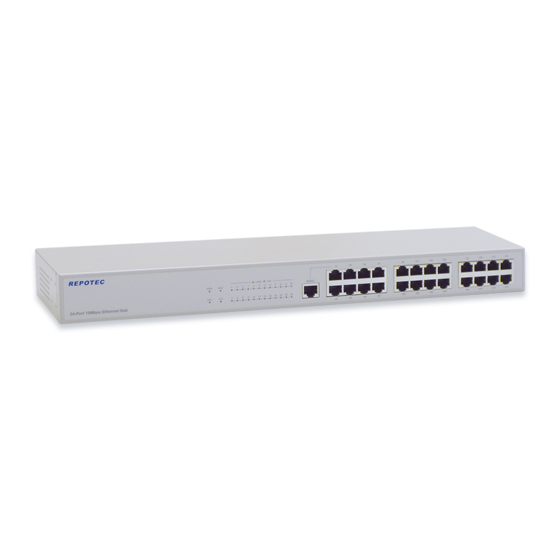
Table of Contents
Advertisement
Quick Links
Advertisement
Table of Contents

Subscribe to Our Youtube Channel
Summary of Contents for Repotec RP-1649RE
- Page 1 16-Port/24-Port Ethernet Hub User’s Guide...
-
Page 2: Fcc Warning
FCC Warning This equipment has been tested and found to comply with the regulations for a Class B digital device, pursuant to Part 15 of the FCC Rules. These limits are designed to provide reasonable protection against harmful interference when the equipment is operated in a commercial environment. -
Page 3: About This Guide
About this Guide This guide provides instructions for installing all of the products described below. These Ethernet Hubs are all Plug and Play compliant for easy installation. 16-Port Ethernet Hub 24-Port Ethernet Hub When designing your cable configuration, it is necessary to strictly observe the Ethernet cabling rules. -
Page 4: Rack Mounting
Rack Mounting The Ethernet Hub may stand alone, or may be mounted in a standard 19-inch equipment rack. Rack mounting produces an orderly installation when you have a number of related network devices. Use the six supplied screws to fasten the supplied mounting brackets to either end of the hub, and fasten the hub into the rack. -
Page 5: Installing Network Cables
Installing Network Cables Your Ethernet Hub is denominated as a 16-port or 24-port Ethernet Hub according to the number of its front-panel 10BaseT ports. Additionally it has two ports whose connectors are on the rear panel: one 10Base2 port (BNC connector), 10Base5 port... -
Page 6: Station Connections With Twisted-Pair Cable
station-cable connections. It is useful to keep this in mind when you have some station equipment whose adapters have no 10BaseT port (RJ-45 connector), and thus can only be connected to the hub through a coaxial cable. Station Connections with Twisted-Pair Cable Connect each station to the Ethernet Hub by means of a twisted-pair straight cable (10BaseT... -
Page 7: Hub-To-Hub Connections With Twisted-Pair Cable
Hub-to-Hub Connections with Twisted-Pair Cable In making a hub-to-hub connection involving a Model 16-Port or 24-Port Ethernet Hub, there is the alternative of using a straight cable. Internal Crossover Features The Ethernet Hubs, Model 16-Port and 24-Port, feature internal cross-over for Uplink The port labeled ”Uplink”... -
Page 8: Thin Coaxial Cable Connections
one another, and the hub-to-hub connection would fail.) Thus rule making hub-to-hub connection with twisted-pair cable is as follows: To make a hub-to-hub connection with a straight cable, Uplink must be selected at one end of the cable, and Uplink must not be selected at the other end of the cable. - Page 9 Sometimes several Ethernet Hubs must be co- located to support a larger array of stations than can be handled by a single Ethernet Hub. Then it is useful to stack the Ethernet Hubs by joining their BNC connectors with 0.5 meters patches of thin coaxial cable.
-
Page 10: Thick Coaxial Cable Connections
Thick Coaxial Cable Connections To connect the Ethernet Hub to a thick coaxial cable (10Base5 cable), it is necessary to have a 10Base5 Ethernet transceiver (tap) on the cable at the Ethernet Hub position. Then run an AUI cable between the transceiver connector and the AUI connector on the rear panel of the Ethernet Hub. -
Page 11: Led Indicators
your Ethernet Hub. See Specifications, below, for power cord details. Ascertain that the power switch on the rear panel of the Ethernet Hub is in the off position. Plug the female end of the power cord firmly into the receptacle on the rear panel of the Ethernet Hub. - Page 12 Power LED ◊ “power good”. OFF: ◊ “power bad.” Check to see if the power adapter properly connected, or if the correct AC power adapter is being used. BNC LED Blinking: ◊ Packet reception occurring. OFF: ◊ No packet reception. AUI LED Blinking: ◊...
-
Page 13: Specifications
Specifications Data transfer rate: 10 Mbps Protocol: CSMA/CD Topologies: Star, Bus EMI Certification: FCC Class B, VCCI-B, CE B AC power: 100 - 240 V, 50 - 60 Hz Power 16-Port: 12 W consumption: 24-Port: 19 W Dimensions: W x H x L, mm (including mounting brackets): 440 x 44 x 122 Weight:... - Page 14 Standard UL, CSA 6012-1624001 Rev.A1-01...












Need help?
Do you have a question about the RP-1649RE and is the answer not in the manual?
Questions and answers